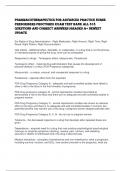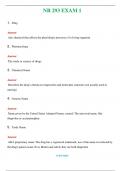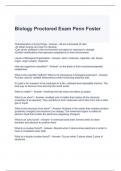PHARMACOTHERAPEUTICS FOR ADVANCED PRACTICE NURSE
PRESCRIBERS PROCTORED EXAM TEST BANK ALL 518
QUESTIONS AND CORRECT ANSWERS|GRADED A+ NEWEST
UPDATE
Six Rights of Drug Administration - Right Medication, Right Amount, Right Time, Right
Route, Right Patient, Right Documentation
side effects - additional effect, desirable, or undesirable, or a drug that is not the primary
or intended purpose of giving the drug; most can be anticipated
Responses to drugs - Teratogenic effect, Idiosyncratic, Paradoxical
Teratogenic effect - maternal drug administration that causes the development of
physcial defects in a fetus (FDA Pregnancy categories)
Idiosyncratic - a unique, unusual, and unexpected response to a drug
Paradoxical - opposite effect from the expected
FDA Drug Pregnancy Category A - adequate and well-controlled studies have failed to
show a risk to the fetus in the first trimester of pregnancy
FDA Drug pregnancy category B - animal reproduction studies have failed to
demonstrate a risk to the fetus and there are no adequate and well-controlled studies in
pregnant women
FDA Drug Pregnancy Category C - animal reproduction studies ahe shown an adverse
effet on the fetus and there is no adequate and well-controlled studies in humans, but
potential benefits may warrant use of the drug in pregnant women despite potential risks
FDA Drug Pregnancy Category D, X, N - do not use in pregnant women
Tolerance - the decreased response to a drug that develops after repeated doses are
given
Dependence - acquired need for a drug that may produce psychological (psychological
cravings) or physical symptoms (retching, nausea, pain, tremors, and sweating,
seizures or death) of withdrawal when the drug is discontinued
Medical Indications - principles of beneficence and non-maleficence; what is prognosis,
including survival, function, and QOL, how certain/uncertain is the prognosis, what are
, the treatment options, what are potential benefits and burdens of disease-focused
treatment; what are potential benefits and burdens of palliative-focused treatment
Patient/Family Preferences - principle of respect for autonomy; how much information
does the patient want about the prognosis, how involved does the patient want others,
does the patient have decision making capabilities, if not, who is the appropriate
surrogate decision maker, has the patient express preferences in an advance directive
or physician order for life-sustaining treatment
Quality of Life - principles of beneficence, non-maleficence, and respect for autonomy;
what are the most important hings for the patient at this time, what is the patient hoping
for, what is the patient fearful of, what is the patient expecting
Contextual Features - principles of justice (loyalty and fairness); is significant moral
distess among staff members present and how is this affecting care, are there important
family dynamics tht must be considered
Synergism - when the actions of two drugs work together in which one promotes the
other simultaneously for an effect that neither could produce alone. drugs that work
together are said to be synergistic
desirable synergism - simvastatin (Zocor) lowers high cholesterol and Gemfibrozil
(Lopid) lowers high triglycerides, so by giving smaller amounts of both together, high
lipid levels can be treated more effectively
undesirable synergism - sedative and barbiturates given in combination can depress the
CNS to dangerous levels i.e death
Potentiation - action of two drugs in which one prolongs or multiples the effect of the
other
desirable potentiation - to build up a high level of some forms of penicillin in the blood,
the drug Probenecid Benemid (gout drug) can be given simutaneously. Probenecid
potentiates the effect of penicillin by slowing down the excretion rate of the antibiotic
#1 Rule - DO NO HARM
Factors to consider when prescribing - Pharmacoeconomics, Patient's age, Education,
Disease's and what stage, Care givers, ALL products taken (APAP)
Pharmacokinetics - What the body does to the drug; ADME= Absorption, Distribution,
Metabolism, Excretion; leading to concentration of drug in plasma
Pharmacodynamics - What the drug does to you; MOA (Mechanism of Action), from
drug concentration in plasma to drug concentration at site of action, usually at cellular
level which will get you desired physiologic drug effet






